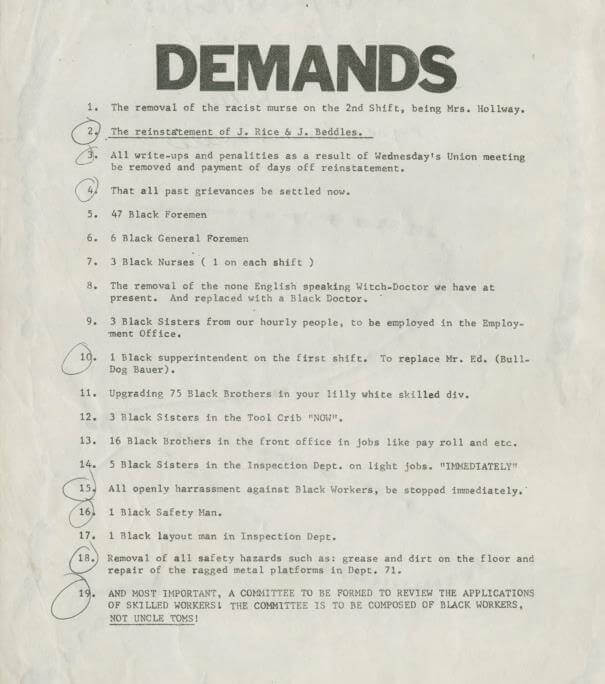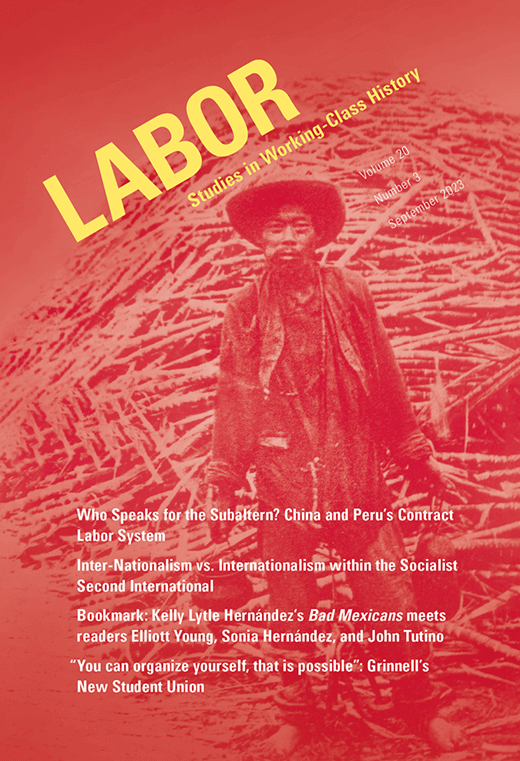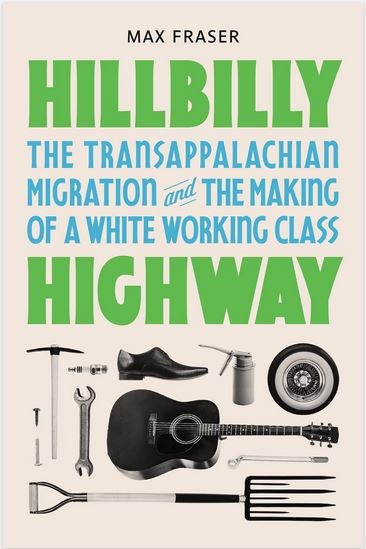“Logan County Bristles with Machine Guns… Gaunt Hollow-eyed Men hold Ridges…Every Path is Guarded.” On September 1st, 1921, Washington Times announced that headline from West Virginia. Ten thousand armed coal miners occupied Blair Mountain in the state’s southern coalfields....
“Logan County Bristles with Machine Guns… Gaunt Hollow-eyed Men hold Ridges…Every Path is Guarded.” On September 1st, 1921, Washington Times announced that headline from West Virginia. Ten thousand armed coal miners occupied Blair Mountain in the state’s southern coalfields. In pitched mountainside battles in the days afterward, the miners aimed their rifles at local and federal law enforcement, who responded with machine guns, bombs and poison gas, exchanging thousands of rounds of ammunition. Coal-industry aligned Sheriff Don Chafin directed aerial bombings on the mountain. Dozens of men lay dead. When the army arrived, the miners finally surrendered their arms. The rebellion remains the largest armed insurrection on American soil since the Civil War. But for decades following the uprising, official histories repressed the record of this mineworkers’ army composed of European immigrants and Black migrants from the South.
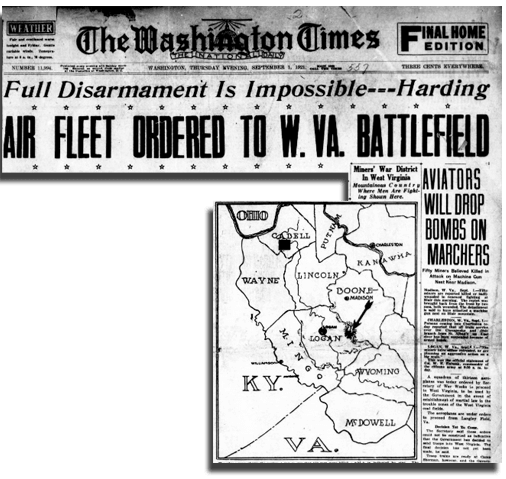 Front page story of the Washington Times, Sept. 1, 1921. Local law enforcement used biplanes to drop bombs on the miners’ positions on Blair Mountain. Source: Library of Congress.
Front page story of the Washington Times, Sept. 1, 1921. Local law enforcement used biplanes to drop bombs on the miners’ positions on Blair Mountain. Source: Library of Congress.
The miners had occupied Blair Mountain to protest deadly working conditions, low wages, and brutal violence against union members. Hundreds of thousands of workers toiled in the region’s deadly mines. Mining families lived in “company towns” owned and operated by their employers and saw their wages garnished as payment for run-down lodgings and meager food rations. Throughout the preceding decade, miners affiliated with the United Mine Workers (UMW) launched repeated efforts to fight for better conditions. Desperate to crush worker organizing, coal bosses turned to hired guns. Mine guards and local law enforcement beat, maimed, and even murdered outspoken workers. In the summer of 1921, skirmishes between company thugs and outraged miners boiled over into an all-out rebellion.
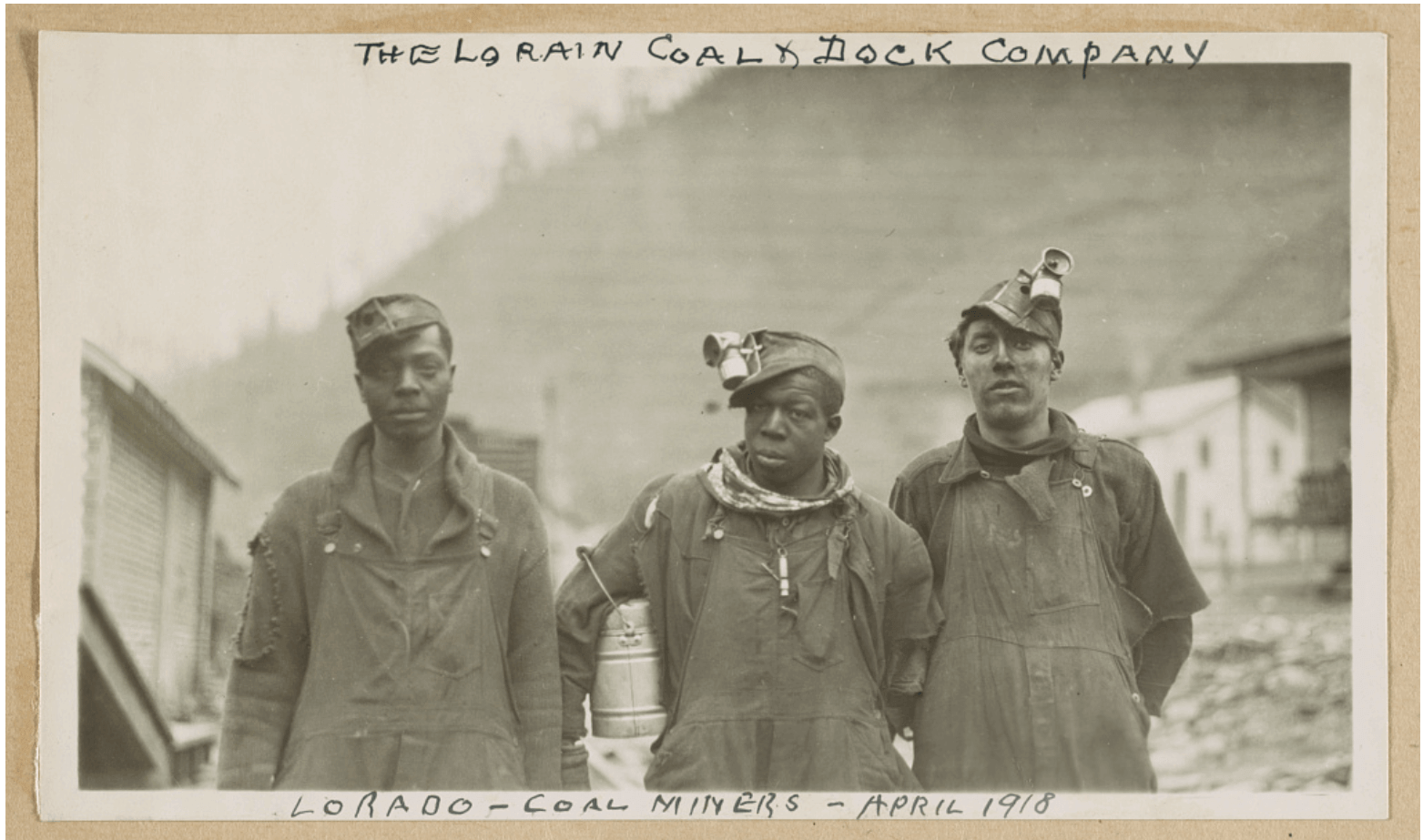 Miners in Lorado, West Virginia 1918. Credit: Library of
Miners in Lorado, West Virginia 1918. Credit: Library of
West Virginia newspapers covered troop movements and battles, but they focused on the hardships mining families endured as bombs and bullets flew on the mountainside. The September 2nd edition of The West Virginian dedicated front-page stories to “Fighting Today on Blair Mountain,” Governor Morgan’s orders to local law enforcement to “cooperate with U.S. forces,” and the plight of “Women Leaving the Theatre of War.” Local outlets also shed light on the people suffering from the violence. On September 7th, the front page of The Wheeling Intelligencer reported on the deaths of two miners. The article included obituaries for the men, Dewey Bryant of Virginia and Kenner Williamson of Kentucky, killed by law enforcement on the mountainside. This humanizing decision was a sharp contrast to national coverage that exoticized strikers.
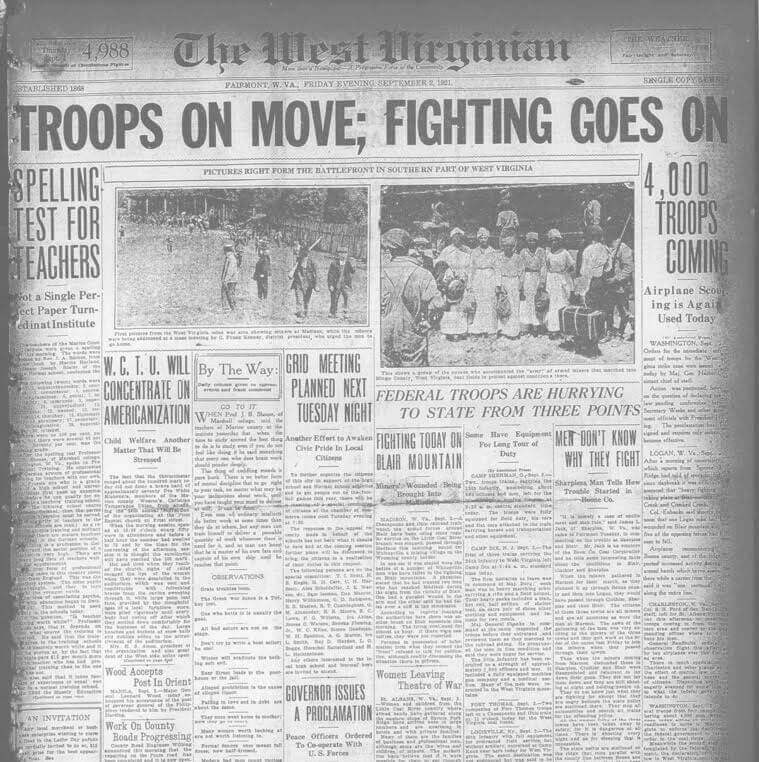 Front page of The West Virginian, Sept. 2, 1921. Photos show a meeting of armed miners and a group of women serving as nurses in the miners’ “army”. While local papers reported closely on the fighting, they also highlighted various perspectives from the affected mining communities. Source: Library of Congress.
Front page of The West Virginian, Sept. 2, 1921. Photos show a meeting of armed miners and a group of women serving as nurses in the miners’ “army”. While local papers reported closely on the fighting, they also highlighted various perspectives from the affected mining communities. Source: Library of Congress.
Local papers also showed more interest in the UMW. Union officials were divided on the wisdom of rebellion. On September 3rd, The Wheeling Intelligencer dedicated its front page to public assurances from UMW officials that the union would “submit to any rules and regulations of the federal authorities.” A critical mediator between miners and federal authorities, the UMW rarely featured prominently in national stories. The Intelligencer later published side-by-side columns by Governor Morgan and UMW Vice President Phillip Morgan. Even when the violence escalated, local papers maintained their emphasis on the people involved in the battles.
On the other hand, tales of West Virginia’s “wild mountains” became a staple in out-of-state media coverage. On September 3rd, the Chicago Eagle published a front-page story announcing the miners’ intent to “defy [an] order of [the] President.” The Eagle also reprinted a Washington Times report on miners singing, “we’ll hang Don Chafin from a sour apple [tree],” during an American Legion meeting. National outlets highlighted the intense violence without exploring the subjects. That same day, the front page of the Indiana Daily Times provided readers with a play-by-play of the fighting in Logan County. The Daily Times informed its readers that “the little mountain town, like Verdun, lies in the shadow of the mountain.” Comparisons with the First World War were a common feature of national coverage. For readers of these outlets, the “Battle of Blair Mountain” felt like a foreign engagement.
As miners from surrounding mines swelled the rebel ranks, coal companies recognized a threat to their business model. The bosses swiftly appealed to state and federal authorities for assistance. West Virginia Governor Ephraim F. Morgan convinced U.S. President Warren G. Harding to impose martial law. Washington dispatched 2,500 federal troops and a squadron of planes to break the strike. Chafin, who annually received over $32,000 from the coal industry, mobilized those planes, which became known as “the Logan Air Force” to bombard striking miners. Federal units arrived in West Virginia equipped with bombs, chemical gasses, and machine guns last used in European trenches. The Wheeling Intelligencer, a local paper, reported on the movements of “chemical units” with disbelief.
Reports of “hillbilly violence” obscured the complex activism taking place on Blair Mountain. In preceding years, more than 80,000 Black migrants had arrived in the southern counties of West Virginia. Black miners joined immigrants recruited by company agents as they disembarked at Ellis Island. A West Virginia judge observed that coal companies were cultivating a “judicious mixture of different people.” Bosses calculated that workers lacking a common language or religion would not unionize, but Blair Mountain shook assumptions about the dividing power of race, ethnicity, and religion. Thousands of workers turned a loose affiliation with a relatively young union into a mass movement threatening to overturn the industry, and coal barons responded ruthlessly. Turning Blair Mountain into “Verdun” wasn’t enough. After the miners’ surrender, officials arrested hundreds of miners and union leaders for “treason” and “murder.” Historian Hoyt Wheeler writes that “union organization in the southern fields was dealt a death blow.” Without organized advocates for safe working conditions, the decade following the Battle of Blair Mountain became the deadliest in the history of Appalachian coal mining.
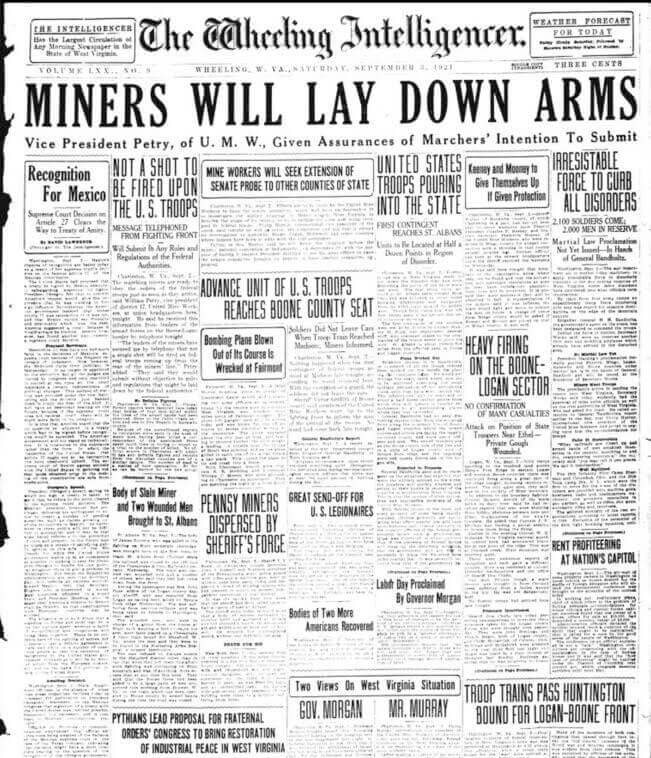 Photo #2: Front page of the Wheeling Intelligencer, Sept. 3, 1921. The paper carried assurances from United Mine Workers officials, updates on wounded miners, and dueling perspectives under the heading “Two Views on West Virginia Situation”. Source Library of Congress.
Photo #2: Front page of the Wheeling Intelligencer, Sept. 3, 1921. The paper carried assurances from United Mine Workers officials, updates on wounded miners, and dueling perspectives under the heading “Two Views on West Virginia Situation”. Source Library of Congress.
Unsurprisingly, the alliance of Black migrants, European immigrants, and “mountain men” taking up arms against tycoons struggled to capture sympathy from the state’s elite in the aftermath of the rebellion. Stereotypes, perpetuated by the national media, contributed to what the editors of The Shepherdstown Register lamented as their state’s “bad reputation.” Unlike other local papers, the Register’s editorial board castigated “armed bands” from Logan Country for their “lawlessness” and lionized the “valiant service” of state troopers. Another local newspaper lamented the “lawlessness that has given the state [a] bad reputation” and thanked federal officers.
 Striking Miners in Lick Creek.1922. Credit: Library of Congress.
Striking Miners in Lick Creek.1922. Credit: Library of Congress.
Divides within West Virginia set the stage for the official erasure of the Battle of Blair Mountain. When the Works Progress Administration (WPA) compiled guidebooks for each state, Governor Homer A. Holt wrote to FDR demanding that the WPA exclude three events: The Hawks Nest Tunnel Disaster, in which hundreds of silica miners died from acute lung disease, the steelworkers strike at Weirton Steel, and the Battle of Blair Mountain. As A. P. Duafala has noted, the prevailing narratives that emerged from the uprising “advanced the cultural ‘othering’ of the Appalachian people” and “permitted the nation to turn a blind eye to Appalachia’s problems.”*
The New Deal reinvigorated unionization in the coalfields—without upending the balance of political power. The unionized industry created jobs that offered a pathway to the middle class. Mining families took pride in their essential role in coal production, and the strife of the early twentieth century became taboo.
But for decades, workers feared retribution from coal bosses if they commemorated the events at Blair Mountain. During the “boom” years, acknowledging the region’s history of militant labor activism felt counterproductive. In 1993, the West Virginia State Historic Preservation Office overruled objections from historians and granted coal companies a permit to build power lines over battle sites.
In 2009, after a public history coalition campaign, the National Register of Historic Places finally recognized Blair Mountain as a historic site, and even then over lawsuits from local coal companies. State censorship and the coal industry’s chilling effect on scholarship helped purge this from national memory.
Contemporary working-class movements in West Virginia have reclaimed the history of Blair Mountain. The West Virginia Mine Wars Museum operates out of a building owned by United Mine Workers of America Local 1440 in Matewan, West Virginia. Its mission is to “remember past struggles when people today are having to fight to keep rights won a century ago.”
According to Executive Director MacKenzie Knew-Walker, the West Virginia teachers’ wildcat strike in 2018 represented a turning point in public remembrance of the Mine Wars. She believes that “before the teacher’s strike, a lot of people didn’t identify with this history…the strike helped shine a spotlight on the Mine Wars. A lot of teachers said, ‘This was in our blood.’” The teachers marched on the state capitol sporting red bandanas as an homage to the miners who tied red bandanas over their faces. In 2019, the “West Virginia Can’t Wait Ticket” ran candidates for statewide and local government offices. In its launch, the campaign channeled the legacy of “West Virginia mineworkers—black, white, and immigrant” who “marched on Blair Mountain against corporate rule.” Despite attempts to erase their struggle, the miners continue to fuel political undercurrents in the state—and serve as a powerful admonition to out-of-state observers who might look at West Virginia as a monolith.
Today’s labor unrest takes place in a fractured media landscape. Local journalism is disappearing. Corporate national outlets vie for clicks and eyes. Workers are articulating ambitious visions for more equitable and sustainable economic structures. Yet, coverage of the contract negotiations between unions and UPS, the Big 3 automakers, and Hollywood studios are characterized by an emphasis on horse-race developments, hand wringing about economic costs, and intrapersonal conflicts that erupt on picket lines. Unions can invest in their own communications efforts to shape narratives. Labor journalists can mimic the role of local reporters by embedding themselves in communities and uplifting stories from the frontlines. Corporate and state interests didn’t just crush the uprising on Blair Mountain, they also fought to eliminate its ability to inspire. A century later, workers, unions, and journalists will all play a role in preserving the radical ethos of the current moment.
* Duafala, A. P. “The Historiography of the West Virginia Mine Wars.” West Virginia History: A Journal of Regional Studies 12, no. 1 (2018): 71–89. https://muse.jhu.edu/article/703896.






